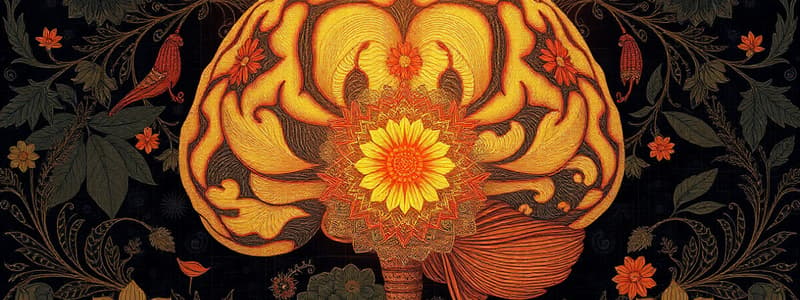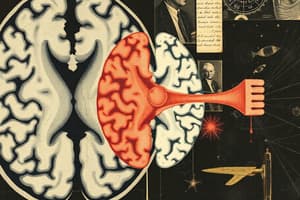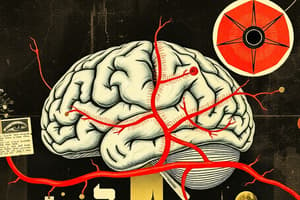Podcast
Questions and Answers
What is the primary function of the blood-brain barrier?
What is the primary function of the blood-brain barrier?
- To provide nutrients to the brain.
- To facilitate communication between the brain and the spinal cord.
- To protect the brain from physical injury.
- To regulate the movement of ions, molecules, and cells between the blood and the brain. (correct)
Which of the following is NOT a common cause of a cerebrovascular accident (CVA)?
Which of the following is NOT a common cause of a cerebrovascular accident (CVA)?
- Embolism
- Thrombosis
- Hypoperfusion
- Hemorrhage (correct)
What is the most common cause of a cerebrovascular accident (CVA)?
What is the most common cause of a cerebrovascular accident (CVA)?
- Hemorrhage
- Thrombosis
- Hypoperfusion
- Embolism (correct)
Which of the following is TRUE about the Circle of Willis?
Which of the following is TRUE about the Circle of Willis?
What is the primary location where most aneurysms occur in the brain?
What is the primary location where most aneurysms occur in the brain?
What is the role of the choroid plexuses in the production of cerebrospinal fluid?
What is the role of the choroid plexuses in the production of cerebrospinal fluid?
Which of the following is NOT a constituent of the Circle of Willis?
Which of the following is NOT a constituent of the Circle of Willis?
What is the main reason why an aneurysm is considered a life-threatening condition?
What is the main reason why an aneurysm is considered a life-threatening condition?
Which of the following cerebral arteries is MOST commonly associated with strokes?
Which of the following cerebral arteries is MOST commonly associated with strokes?
Which part of the brain is supplied by the posterior cerebral arteries?
Which part of the brain is supplied by the posterior cerebral arteries?
The grey matter of the brain is characterized by:
The grey matter of the brain is characterized by:
What is the relationship between the vertebral arteries and the Circle of Willis?
What is the relationship between the vertebral arteries and the Circle of Willis?
What is the main function of cerebrospinal fluid?
What is the main function of cerebrospinal fluid?
Which of the following areas of the brain is NOT primarily supplied by the middle cerebral arteries?
Which of the following areas of the brain is NOT primarily supplied by the middle cerebral arteries?
What is the significance of the Circle of Willis in brain circulation?
What is the significance of the Circle of Willis in brain circulation?
Multiple sclerosis affects the central nervous system by:
Multiple sclerosis affects the central nervous system by:
What is the primary function of Cerebrospinal Fluid (CSF)?
What is the primary function of Cerebrospinal Fluid (CSF)?
Which of the following is NOT a characteristic of Hydrocephalus?
Which of the following is NOT a characteristic of Hydrocephalus?
What is the normal range for Intracranial Pressure (ICP) in a supine adult?
What is the normal range for Intracranial Pressure (ICP) in a supine adult?
How is CSF absorbed back into the bloodstream?
How is CSF absorbed back into the bloodstream?
What is the main difference between communicating and non-communicating hydrocephalus?
What is the main difference between communicating and non-communicating hydrocephalus?
Which of the following is a potential cause of non-communicating hydrocephalus?
Which of the following is a potential cause of non-communicating hydrocephalus?
What is the name of the closed spaces that serve as reservoirs for CSF at the base of the brain?
What is the name of the closed spaces that serve as reservoirs for CSF at the base of the brain?
Where is CSF produced?
Where is CSF produced?
What characterizes communicating hydrocephalus?
What characterizes communicating hydrocephalus?
What is a key feature of obstructive hydrocephalus?
What is a key feature of obstructive hydrocephalus?
What is a primary characteristic of the Cognitive Stage of motor learning?
What is a primary characteristic of the Cognitive Stage of motor learning?
Which stage of motor learning involves refinement of skills through repetition?
Which stage of motor learning involves refinement of skills through repetition?
What impact does neuroplasticity have on motor control?
What impact does neuroplasticity have on motor control?
What describes the Autonomous Stage of motor learning?
What describes the Autonomous Stage of motor learning?
What supports the continuation of motor learning throughout life?
What supports the continuation of motor learning throughout life?
What signifies the need for a ventriculoperitoneal shunt?
What signifies the need for a ventriculoperitoneal shunt?
What is the primary benefit of practicing motor skills repeatedly?
What is the primary benefit of practicing motor skills repeatedly?
Which type of feedback involves using one's own sensory information?
Which type of feedback involves using one's own sensory information?
What does the practice of motor skills as a 'whole' involve?
What does the practice of motor skills as a 'whole' involve?
What is a characteristic of variable practice?
What is a characteristic of variable practice?
How does the 'Whole-Part-Whole' practice method function?
How does the 'Whole-Part-Whole' practice method function?
What happens to the physiological systems with aging that affects motor skills?
What happens to the physiological systems with aging that affects motor skills?
Which practice schedule involves practicing skills less frequently but in a planned manner?
Which practice schedule involves practicing skills less frequently but in a planned manner?
What is the primary goal of motor skill refinement during practice?
What is the primary goal of motor skill refinement during practice?
Flashcards
Posterior cerebral arteries
Posterior cerebral arteries
Arteries supplying the occipital and parts of the temporal lobes, including the visual cortex.
Blood–brain barrier
Blood–brain barrier
A selective barrier that regulates the movement of substances between the blood and the brain.
Cerebral Vascular Accident (CVA)
Cerebral Vascular Accident (CVA)
A stroke characterized by neurological deficits due to blood supply issues in the brain.
Thrombosis
Thrombosis
Signup and view all the flashcards
Embolism
Embolism
Signup and view all the flashcards
Hypoperfusion
Hypoperfusion
Signup and view all the flashcards
Intracerebral Aneurysm
Intracerebral Aneurysm
Signup and view all the flashcards
Cerebrospinal fluid
Cerebrospinal fluid
Signup and view all the flashcards
Central Nervous System (CNS)
Central Nervous System (CNS)
Signup and view all the flashcards
Grey Matter
Grey Matter
Signup and view all the flashcards
White Matter
White Matter
Signup and view all the flashcards
Circle of Willis
Circle of Willis
Signup and view all the flashcards
Anterior Cerebral Arteries
Anterior Cerebral Arteries
Signup and view all the flashcards
Middle Cerebral Arteries (MCA)
Middle Cerebral Arteries (MCA)
Signup and view all the flashcards
Multiple Sclerosis
Multiple Sclerosis
Signup and view all the flashcards
CSF functions
CSF functions
Signup and view all the flashcards
Buoyancy of CSF
Buoyancy of CSF
Signup and view all the flashcards
CSF production
CSF production
Signup and view all the flashcards
Hydrocephalus
Hydrocephalus
Signup and view all the flashcards
Causes of Hydrocephalus
Causes of Hydrocephalus
Signup and view all the flashcards
Ventricular system
Ventricular system
Signup and view all the flashcards
Intracranial pressure (ICP)
Intracranial pressure (ICP)
Signup and view all the flashcards
Communicating Hydrocephalus
Communicating Hydrocephalus
Signup and view all the flashcards
Non-communicating Hydrocephalus
Non-communicating Hydrocephalus
Signup and view all the flashcards
Ventriculoperitoneal Shunt (VP Shunt)
Ventriculoperitoneal Shunt (VP Shunt)
Signup and view all the flashcards
External Ventricular Drain (EVD)
External Ventricular Drain (EVD)
Signup and view all the flashcards
Motor Learning
Motor Learning
Signup and view all the flashcards
Stages of Motor Learning
Stages of Motor Learning
Signup and view all the flashcards
Cognitive Stage of Learning
Cognitive Stage of Learning
Signup and view all the flashcards
Neuroplasticity
Neuroplasticity
Signup and view all the flashcards
Motor Skills Acquisition Stages
Motor Skills Acquisition Stages
Signup and view all the flashcards
Intrinsic Feedback
Intrinsic Feedback
Signup and view all the flashcards
Extrinsic Feedback
Extrinsic Feedback
Signup and view all the flashcards
Whole Practice
Whole Practice
Signup and view all the flashcards
Variable Practice
Variable Practice
Signup and view all the flashcards
Progressive Sequential Learning
Progressive Sequential Learning
Signup and view all the flashcards
Physiologic Changes with Aging
Physiologic Changes with Aging
Signup and view all the flashcards
Self-Correction
Self-Correction
Signup and view all the flashcards
Study Notes
CNS Vascular System
- The central nervous system (CNS) is composed of grey matter and white matter
- Grey matter is the outer layer of the brain, containing cell bodies
- White matter contains axons with myelin, crucial for functioning
- Both grey and white matter are essential parts of the brain and spinal cord
- Grey matter's color comes from the high concentration of neuronal cell bodies
Neurons
- Neurons have dendrites, a nucleus, a soma (cell body), axons, and axon terminals
- Myelin sheaths surround the axons
- Multiple sclerosis is a condition where myelin sheaths break down
CNS Circulation
- Two paired arteries supply blood to the brain: vertebral and internal carotid arteries
- These arteries ascend from the neck to the cranium
- Terminal branches form the Circle of Willis, an anastomotic circle
- The Circle of Willis supplies blood to much of the cerebrum
- Smaller branches from the vertebral arteries supply parts like the pons and spinal cord
Arterial Circle of Willis
- The terminal branches of the vertebral and internal carotid arteries form the circle
- This circle is vital for blood flow
- Components include anterior and middle cerebral arteries, posterior cerebral arteries, and connecting anterior and posterior communicating arteries.
- Middle cerebral artery (MCA) is most commonly affected in stroke
Blood Supply to the Cerebrum
- Three cerebral arteries (anterior, middle, and posterior) supply different parts of the cerebrum
- Anterior cerebral arteries supply the lower limbs’ motor and sensory areas
- Middle cerebral arteries supply the upper limbs, face, Broca's area (in dominant frontal lobe), and Wernicke's area (in dominant temporal lobe)
- Posterior cerebral arteries supply the occipital lobe and parts of the temporal lobe, including the visual cortex
Blood-Brain Barrier
- Blood vessels in the central nervous system have unique properties creating the blood-brain barrier (BBB)
- The BBB tightly controls the movement of ions, molecules, and cells between blood and brain
- This control ensures proper neuronal function and protects neural tissue from toxins, pathogens, inflammation, and disease
- The BBB can be an obstacle for drug delivery to the CNS
Cerebral Vascular Accident (Stroke)
- The brain is sensitive to oxygen starvation
- A stroke is an acute neurological deficit due to blood supply disruption
- Causes include thrombosis (local blood clot), embolism (blood clot elsewhere), hypoperfusion (low blood pressure), and hemorrhage (blood accumulation)
- Embolism is the most common cause, often stemming from neck vessels
Intracerebral Aneurysms
- An aneurysm is a bulge or dilation of an artery larger than 50% of normal size
- Aneurysms often originate in vessels contributing to the Circle of Willis blood supply
- These are usually asymptomatic until they rupture
- Rupture causes blood to accumulate in the subarachnoid space, leading to increased intracranial pressure
- Rupture is a life-threatening emergency requiring surgical intervention
Cerebrospinal Fluid (CSF)
- CSF is a clear, colorless body fluid found in the brain and spinal cord
- It's produced by ependymal cells in the choroid plexuses of the brain ventricles and absorbed by arachnoid granulations
- CSF functions to keep the brain buoyant (“shock absorber”), deliver nutrients and remove waste, and flow between the cranium and spine to compensate for intracranial pressure changes
CSF Circulation
- CSF flows through the ventricles connected by narrow passages, exiting into cisterns on the brain's base
- It bathes brain and spinal cord surfaces, then re-enters the bloodstream
CSF Pressure
- Intracranial pressure (ICP) is the pressure inside the skull and, thus, the brain tissue and CSF
- Measured in millimeters of mercury (mmHg)
- Normal ICP, at rest, ranges from 7-15 mmHg
Hydrocephalus
- Hydrocephalus is a condition where the balance of CSF production and absorption is disrupted
- Congenital or acquired, it can disrupt the flow in communicating vs non-communicating ways
Ventriculoperitoneal Shunt (VP Shunt)
- A shunt allows CSF drainage from the brain to another part of the body
- Often a permanent or semi-permanent surgical procedure
- Necessary for growth, infection or other conditions
External Ventricular Drain (EVD)
- A temporary drainage device for collecting CSF
- Often done as an alternative or intermediary to VP shunts
Motor Learning
- Motor learning, occurs throughout life, if the environment changes the central nervous system (CNS) has plasticity
- Learning new movements, like walking on varied terrains, involves a process with cognitive, associative, and autonomous stages
- The brain can re-adapt and relearn skills despite damage
- The process of acquiring new motor skills or relearning lost ones
Feedback
- Intrinsic feedback is inherent to the body (e.g., sensory, visual, proprioceptive, and tactile/somatosensory).
- Extrinsic feedback is augmented/provided by external sources (e.g., verbal and manual).
Practice of Motor Skills
- Techniques for practicing motor skills include Whole (practicing all steps together), Pure Part (practicing steps in isolation — forward or backward), and Progressive Sequential (teaching parts sequentially). A combination of methods (Whole-Part-Whole, for example) might be useful
Practice Schedules
- Practice scheduling considers factors like constant, variable, or intermittent patterns
- Practice is often done independently or with caregiver help
Summary of Motor Learning Context
- Motor skills evolve to meet a patient's need to interact with the environment
- Functional skills support activities like work, play, and leisure
Additional Notes
- The provided text discusses various aspects of the Central Nervous System (CNS), especially the vascular system and motor learning. The detailed study notes accurately cover important concepts and procedures.
Studying That Suits You
Use AI to generate personalized quizzes and flashcards to suit your learning preferences.




